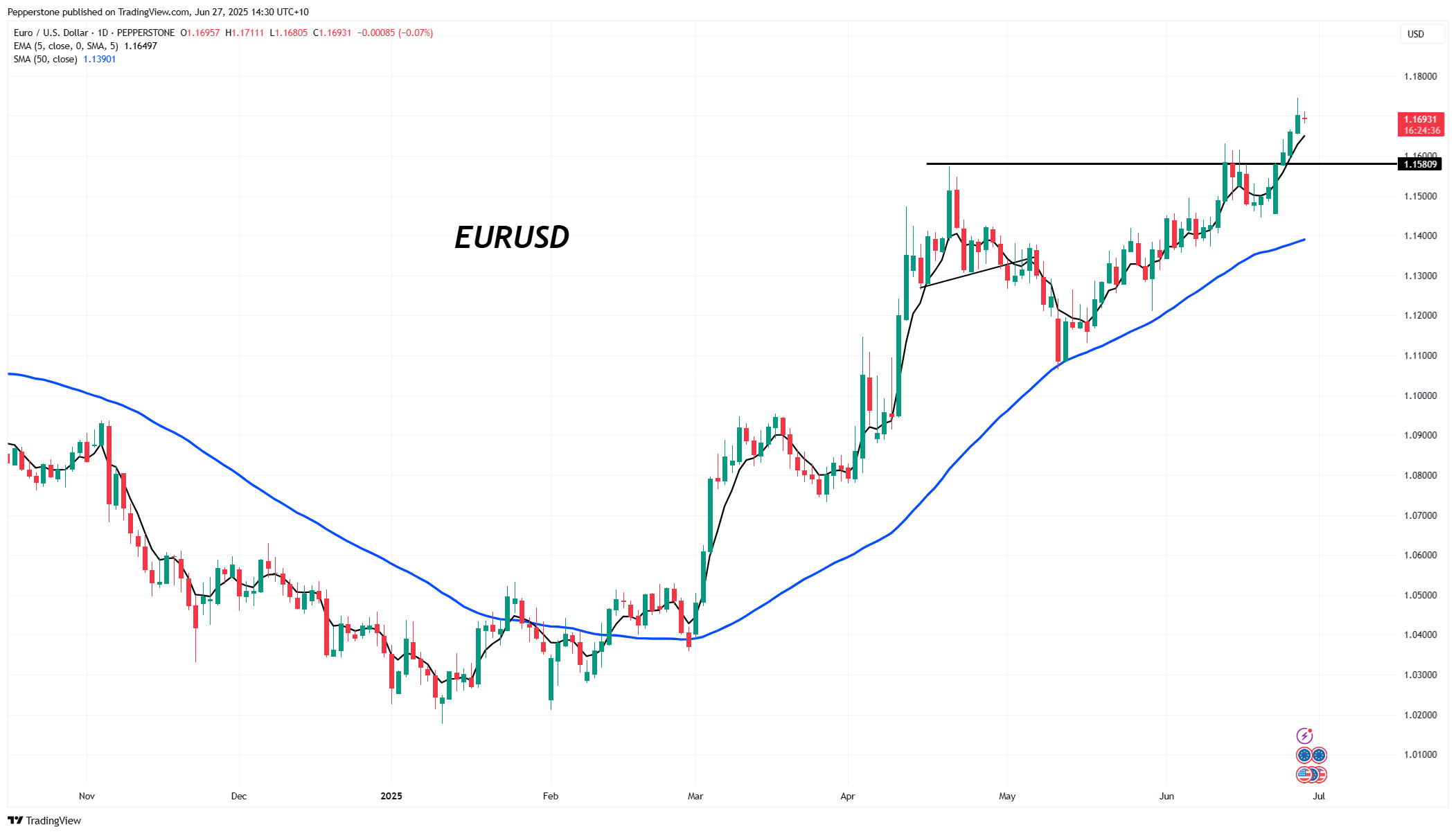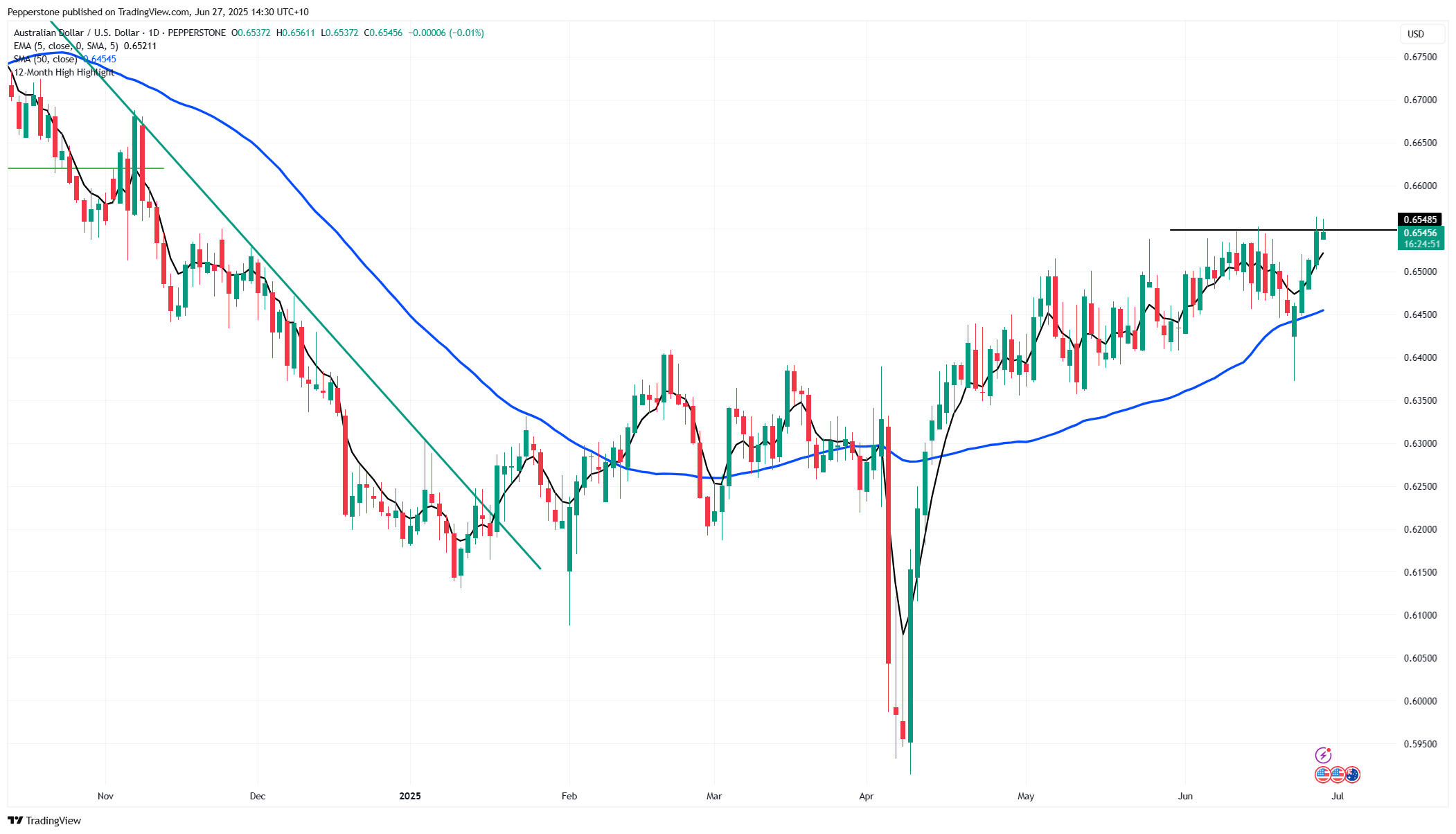CFDs are complex instruments and come with a high risk of losing money rapidly due to leverage. 80% of retail investor accounts lose money when trading CFDs with this provider. You should consider whether you understand how CFDs work and whether you can afford to take the high risk of losing your money.
- English
- 简体中文
- 繁体中文
- ไทย
- Tiếng Việt
- Español
- Português
- لغة عربية
US Dollar Breaking Down: Key Drivers Behind the Decline & Risks Ahead

The US dollar Index (DXY) put in a daily close below its June 12 low of 97.61, with price trading to a low of 97.01, the weakest level since March 2022. With the DXY −2.1% in June, this marks the fifth consecutive monthly decline for the USD index and the worst run of form since mid-2017.

EURUSD traded to a session high of 1.1744 (the highest level since 2021) before closing the session at 1.1701. We’re seeing minimal follow-through in Asia, but with the bull trend defined by the rising 5-day EMA, until we see a daily close below this short-term EMA, buyers should use intraday weakness to add to longs and the lofty target of 1.2000 is not unrealistic.
GBPUSD holds firmly above 1.37 (last seen in 2021) and looks to move further toward 1.3800. USDCHF has taken out the April low of 0.8039 and trades at the weakest levels since 2015 – it could move lower toward 0.8000 in the session ahead, with shorts looking to part-cover on a reversal back through 0.8035.

The market runs a short USD position, and while that net position isn’t as extreme as some suggest, it could be challenged or even build with U.S. core PCE due in the session ahead—and as we look toward the event risk for the week ahead, USD flows will be impacted by the outcome of the U.S. ISM manufacturing report, JOLTS job openings, nonfarm payrolls, and the ISM services report. We can also expect some focus on tariff headlines and the debate on fiscal policy in the Senate.
As FX players move on from the Iran-Israel conflict and navigate further month-end flows, the price action in the USD and the failure of the USD to stage any meaningful counter-rally, with traders quick to sell into strength, speaks volumes—the reasons behind the disdain for the USD seem plentiful and easily explain the bear trend.
Those that are front of mind include:
1. Equity–US dollar correlation. The 20-day rolling correlation between the S&P 500 and the DXY sits at –0.79. That’s as strong an inverse relationship as we’ve seen since January; under current dynamics, when the S&P 500 rallies, the dollar falls.
2. Fed leadership uncertainty. Media reports that Trump could make an earlier than expected announcement on his pick to replace Jerome Powell, whose tenure as Fed chair ends in May 2026. This approach reduces the perception of Fed independence and the freedom for the Fed chair to set policy without interference. Essentially, a “shadow” Fed chair undermines credibility of US monetary policy, and that does not sit well with foreign investors.
3. The U.S. becoming less ‘exceptional’ – U.S. growth and labour markets are facing increasing downside risks, notably in Q325 – and, while China and EU growth is hardly blowing the lights out; the greater concern for markets falls on the U.S. economy.
4. Foreign-capital hedging flows. With foreign investors racking up an incredible US$31 trillion in U.S. assets (across equity, fixed income, and credit)—a function of U.S. exceptionalism—this USD notional exposure has been called into question, with foreign investors either reducing their exposure to the U.S. or increasing USD hedging ratios. Trump’s unpredictable and erratic policy agenda is a major catalyst behind these flows.
5. Interest-rate differentials offering EUR tailwinds. EUR vs. U.S. 1-year forward swap differentials have risen from –172 bp in early June to –136 bp. This reflects shifting rate-cut expectations, with the market pricing in additional rate from the Fed later this year while paring back ECB-cut bets. 6. Fiscal dynamics. Upward revisions to China’s growth outlook from economists, plus the compelling 2026 fiscal plans from the German govt, contrast with ever-increasing U.S. public debt and U.S. deficits projected near 6% of GDP for years ahead.
For the USD to see a sustained counter-rally, I would argue we’d need U.S. growth to pick up and an implied Fed rate cuts to be repriced —perhaps with growth data in Europe and China also slowing. That doesn’t seem likely in the near term, and as such, rallies in the USD are likely to be quickly sold off, with the downtrend set to continue.
Good luck to all.
The material provided here has not been prepared in accordance with legal requirements designed to promote the independence of investment research and as such is considered to be a marketing communication. Whilst it is not subject to any prohibition on dealing ahead of the dissemination of investment research we will not seek to take any advantage before providing it to our clients.
Pepperstone doesn’t represent that the material provided here is accurate, current or complete, and therefore shouldn’t be relied upon as such. The information, whether from a third party or not, isn’t to be considered as a recommendation; or an offer to buy or sell; or the solicitation of an offer to buy or sell any security, financial product or instrument; or to participate in any particular trading strategy. It does not take into account readers’ financial situation or investment objectives. We advise any readers of this content to seek their own advice. Without the approval of Pepperstone, reproduction or redistribution of this information isn’t permitted.